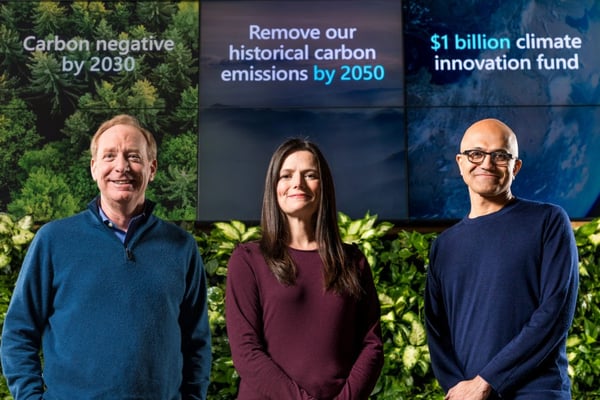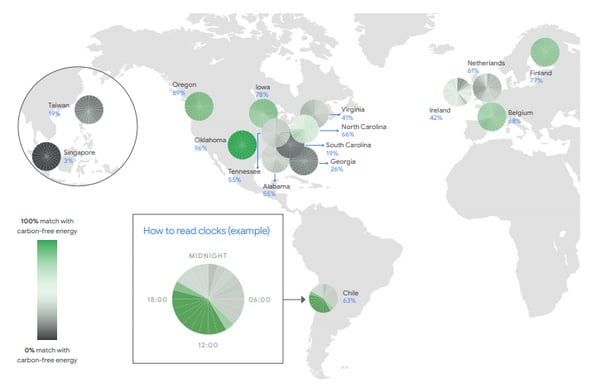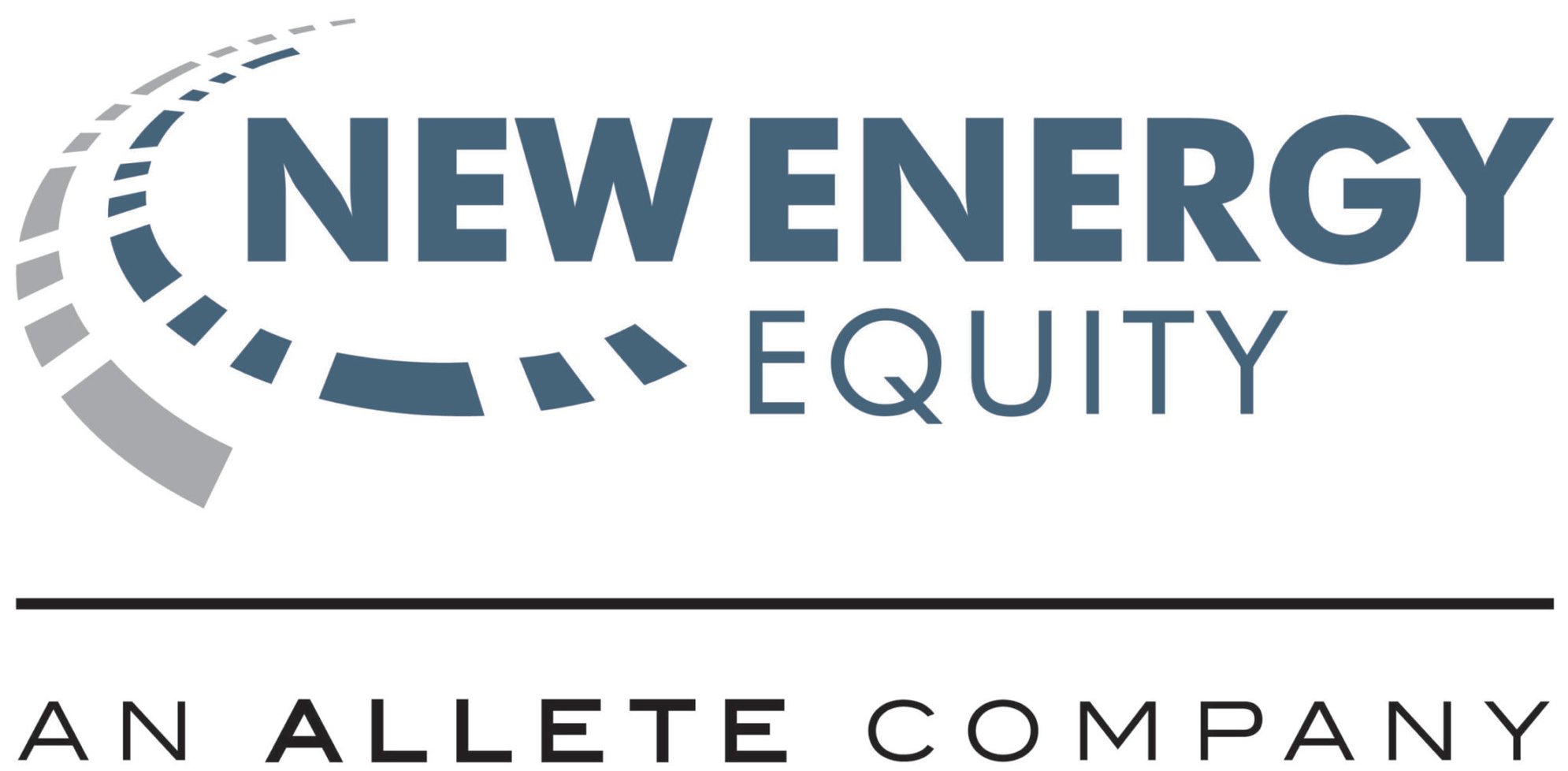New Energy Insights
- Home /
- New Energy Insights /
- Big Tech’s Big Moves on Climate
Since the 90s’ dot com boom and bust, internet and software companies have dominated the business landscape. The Tech business model is drastically different from traditional models because, for the first time in history, businesses can be profitable without owning almost any physical assets. Besides data centers, employee laptops, and a good wifi connection, what else do you really need to write software? Nowadays, it’s hard to imagine a world without tech companies – whether it’s in the community you live in, your home, or your pocket, these companies have modernized our society in many ways, and they continue to innovate their way into the future.
Companies across diverse sectors of the economy are now demanding sustainable solutions and some are committing to operating in environmentally responsible ways. This transition has by-and-large been led by tech companies like Microsoft, Google, Apple, and Amazon- so what exactly are their plans?
Microsoft: Carbon Negative by 2030, Remove Historical Carbon Emissions by 2050, $1B Climate Innovation Fund1

Microsoft President Brad Smith, CFO Amy Hood, and CEO Satya Nadella preparing to announce Microsoft’s plan to be carbon negative by 2030
First, let’s take a look at Microsoft’s commitment to be carbon negative in ten years. In addition to committing to being carbon negative, Microsoft will offset all of its historical emissions since it was founded in 1975. To achieve this, it released a bold, yet detailed plan. Quoted from their blog below:
- Grounding in science and math. We will continually ground our work in the best available science and most accurate math, as we describe further below.
- Taking responsibility for our carbon footprint. We will take responsibility for all our emissions, so by 2030 we can cut them by more than half and remove more carbon than we emit each year.
- Investing for new carbon reduction and removal technology. We will deploy $1 billion of our own capital in a new Climate Innovation Fund to accelerate the development of carbon reduction and removal technologies that will help us and the world become carbon negative.
- Empowering customers around the world. Perhaps most importantly, we will develop and deploy digital technology to help our suppliers and customers reduce their carbon footprints.
- Ensuring effective transparency. We will publish an annual Environmental Sustainability Report that provides transparency on our progress, based on strong global reporting standards.
- Using our voice on carbon-related public policy issues. We will support new public policy initiatives to accelerate carbon reduction and removal opportunities.
One area they pay particular attention to is the precise definitions of Scope 1, Scope 2, and Scope 3 emissions, all of which they are committed to addressing.
Scope 1: Emissions are the direct emissions that an entities’ activities create. For example: if the company is driving a truck or running generators.
Scope 2: Emissions are indirect emissions that come from the production of electricity or heat an entity uses.
Scope 3: The thorniest – are indirect emissions that come from all other activities, such as the food an entity eats, or the products one buys. For businesses, this gets extremely complex very quickly when one considers all the supply chain partners and associated company operations that need to be decarbonized.
There is a lot more to unpack here, but the last point to emphasize is their use of an internal price on carbon at $15/metric ton. Each Microsoft business division will pay that fixed fee for Scope 1, Scope 2, and Scope 3 emissions, and all funds collected are then used to pay for sustainability improvements. A carbon price can be an extremely effective way for an organization to measure and reduce their emissions, as it provides a simple incentive to alter behavior.
Microsoft is essentially committing to a net-zero global supply chain by 2030 and to offsetting all of its historical emissions by 2050. This is a very ambitious goal, perhaps even audacious. NEE is excited to see Microsoft blaze the trail and set an example for other companies.
Google: 24/7 Carbon-Free by 20303
The next software giant is none other than the world’s largest corporate purchaser of clean energy: Google. While Microsoft’s goal of carbon negative by 2030 is impressive, keep in mind that their goal is “net-zero.” Google, on the other hand, pledges to be 24/7 carbon-free by 2030.
Google is an almost purely software-based company, so their primary source of emissions stems from energy use at their data centers. Powering data centers with solar or wind power might seem easy enough but consider the fact that the sun is not always shining, the wind is not always blowing, but Google is always there for your internet-searching needs. That means that Google uses electricity around the clock, at times being powered by clean energy but often using dirty fossil fuels. Google will undoubtedly use increasing amounts of solar and wind energy, especially considering the falling cost of these resources.

Carbon-free energy performance at Google data centers in 2019, ranging from 3% in Singapore to 96% in Oklahoma. Perhaps a new metric we should all be adopting?
What steps does Google plan to take to make this goal a reality?
- Advance new approaches for procuring clean energy;
- Drive progress in next-generation technologies; and
- Work with partners to advocate for smart public policy
Of most interest to New Energy Equity is Google’s interest in advancing clean energy transactional models. To achieve this, Google intends to (1) move from single-source PPAs to multi-source and multi-technology blended PPAs; (2) create utility programs to enable broader access to affordable clean energy; and (3) develop new models where multiple users can share clean energy assets.
Already, Google’s Smart Thermostat – Nest – serves as a crucial instrument that allows homes to be dynamic nodes on the grid and provides the foundation from which to continue building the Smart Grid of the future. Overall, their commitment to 24/7 carbon-free data centers around the world will be especially valuable to utilities and grid managers because their interests align. With Google’s data and technical prowess, NEE is extremely optimistic about the future of demand response.
Apple: 100% Carbon Neutral Supply Chain and Products by 20304
The previous two companies’ commitments were impressive, but they are primarily software companies, which means they only have to deal with their energy usage. Apple’s business model, on the other hand, is vastly different. While a significant portion of their revenues are generated from the App Store and other services, over 75% of their revenue comes from sales of their iPhone, Mac, iPad, and accessories.5 These are physical products that are built using energy intensive manufacturing processes and complicated supply chains.
Apple is already carbon neutral for their corporate emissions worldwide, however as mentioned previously with Scope 1, 2, and 3, Scope 3 will always be the most difficult emissions to account for. Here is Apple’s plan:
- Implementing low carbon product design
- Expanding energy efficiency
- Using renewable energy
- Innovating their processes and materials
- Investing in 1) natural carbon removal like planting trees, mangroves, kelp forests and 2) conservation efforts to stop the destruction of already-existing resources
As with most of the companies discussed, Apple’s plan is to reduce its emissions as much as possible, while simultaneously engaging in carbon removal practices. Their biggest decarbonization challenge will be its manufacturing process. One way Apple is addressing this is by supporting the development of the first-ever direct carbon-free aluminum smelting process. In addition, through a partnership with Carnegie Mellon, Apple is developing innovative recycling techniques. Namely, Apple needs to recoup rare earth magnets, tungsten, and steel – for which it has invented disassembly and recycling robots, “Dave and Daisy.”
Amazon: Net Zero Carbon by 20406
Last, but certainly not least on the list of companies with impressive climate commitments, is Amazon. Though their timeline is further out than the others on this list, Amazon has a more challenging task because of the nature of its business. Its commitments are as follows:
- Net Zero Carbon by 2040
- 50% of all shipments net zero carbon by 2030
- 100% Renewable Energy by 2025
- 100,000 Electric Delivery Vehicle
- Climate Pledge Fund - $2B towards clean tech R&
- Right Now Climate Fund - $100M towards reforestation and climate mitigation projects
Most notably, Amazon has the massive buying power to provide certainty for the EV market. Tesla, Rivian, Nikola, and others in this space have certainly spiked market interest in medium- and heavy-duty electric trucks, but Amazon is especially well positioned to purchase EVs on a massive scale. Moreover, Amazon’s commitments to keeping their bottom line as low as possible will further incentivize producers to create fully autonomous vehicles so that electric, AI-powered fleets can operate at a fraction of the cost. It will be interesting to see which technology ends up dominating the delivery truck space: will it be electric trucks, or hydrogen-fueled?
References:
- https://blogs.microsoft.com/blog/2020/01/16/microsoft-will-be-carbon-negative-by-2030/
- https://www.microsoft.com/en-us/corporate-responsibility/sustainability/climate-innovation-fund
- https://www.gstatic.com/gumdrop/sustainability/247-carbon-free-energy.pdf
- https://www.apple.com/newsroom/2020/07/apple-commits-to-be-100-percent-carbon-neutral-for-its-supply-chain-and-products-by-2030/
- https://www.apple.com/newsroom/2020/04/apple-reports-second-quarter-results/
- https://sustainability.aboutamazon.com/about/the-climate-pledge
How Can New Energy Equity Help You Reach Your Solar Goals?
Stay up-to-date with New Energy Equity by joining our mailing list.

.png)
